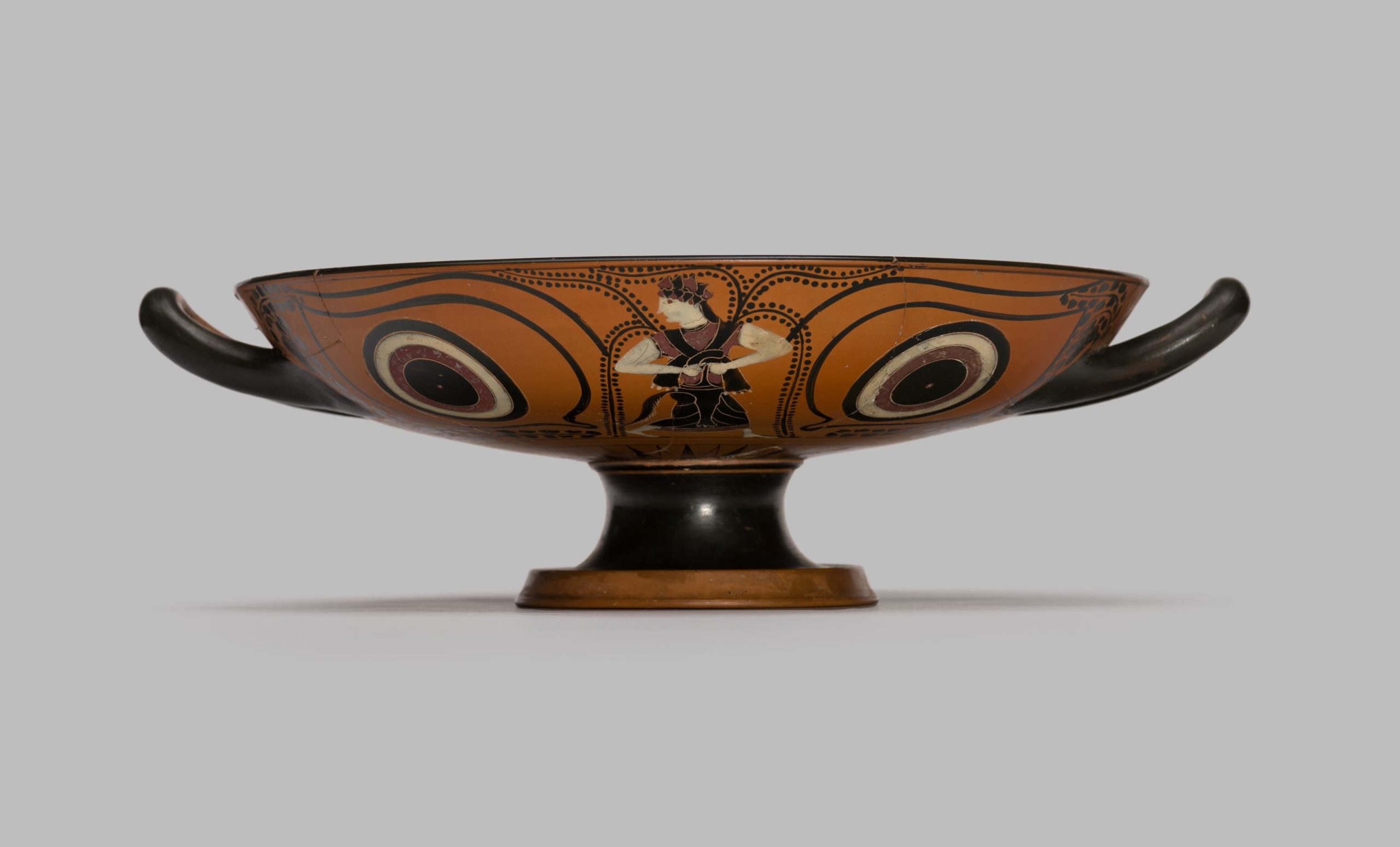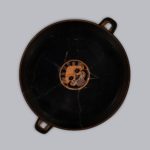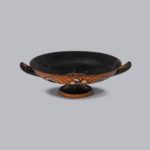
Eye Cup [Gr7]
Athenian Black-Figure, by the Krokotos Workshop, c. 530 BC
Painted terracotta (h. 10.8 cm, w. 36 cm), mended
The interior painted black with a tondo in the centre depicting a gorgoneion (an image of the head of a Gorgon). On each side of the exterior a maenad facing left, framed by a pair of eyes. Vines around the handles with incised bunches of grapes and a band of linear pattern around the stem.
This kylix (drinking cup) is attributed by art historians to the Krokotos workshop, a group of painters active in Athens in the last few decades of the late 6th century. There are several other very similar cups in other museums also featuring a gorgon’s head like the one depicted here, and with similar vine branches around the handles. A cup in the Middlebury College Museum of Art, Vermont has a near-identical design, as does one in the Staatliche Antikensammlungen, Munich. These closely related kylikes are sometimes referred to as the ‘Winchester Group’, but also as the ‘Group of Walters 48.42’ after another similar cup in the Walters Art Museum, Baltimore.
Like other vases produced by the Krokotos Workshop, this cup shows the influence of Exekias, a vase painter active in Athens from around 545 to 530 BC, who was (along with the Amasis Painter) one of the most innovative and accomplished black-figure painters.
The motif of a gorgon’s head is found on pottery from the 7th century BC onwards, and may have been seen as having apotropaic (evil-averting) properties. The eyes painted on the outside of many Athenian drinking cups are sometimes interpreted as having similar powers, though it has also been suggested that the eyes are there to give the vase ‘sight’, or were there simply for decorative purposes.
The maenads depicted on this vase were followers of Dionysus, mortal women who were part of the culture of intoxication and frenzy associated with the wine god. Dionysiac images were some of the most popular mythological themes on Athenian pottery. The maenads here are wearing chitons, ivy wreaths and animal skins.
This cup has extensive added colour. Red has been used for the Gorgon’s tongue, alternate locks of hair, and the pupils of the eyes. The maenads’ skin is painted white – as is typical of female figures on black-figure pottery – and parts of their clothing are picked out in red and white.
Literature: J. Falconer and T. Mannack, Corpus Vasorum Antiquorum: Great Britain, Fascicule 19: Winchester College (Oxford, 2002), pp. 2-3, plate 2.1-3; J.D. Beazley, Paralipomena: Additions to Attic Black-Figure Vase-Painters and to Attic Red-Figure Vase-Painters (Oxford, 1971), p. 94; The Wykehamist, No. 1310 (2 December 1963); J.D. Beazley, Attic Black-Figure Vase-Painters (Oxford, 1956), p. 206.6; A.D. Ure, ‘Krokotos and White Heron’, Journal of Hellenic Studies 75 (1955), p. 99, plates 12.14, 14.15; J. Chittenden and C. Seltman, Greek Art, a Commemorative Catalogue of an Exhibition held in 1946 at the Royal Academy, (London, 1947), p. 7 (no. 76); N. Oakeshott, ‘Three Black-figured Vases in the Winchester College Museum’, Journal of Hellenic Studies 59 (1939), p. 285, figs 2-3; Winchester College Memorial Buildings: Department of Classical Art (Winchester, 1909), p. 17 (no. 40)
Exhibited: Royal Academy of Arts, Burlington House, London, 15 February – 17 March, 1946, no. 76
Provenance: From Orvieto, at Winchester College by 1909
Location: Treasury, Gallery 3



